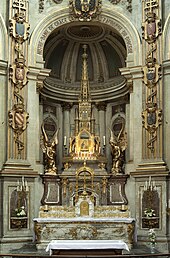Cambrai Cathedral

The Cathedral of Cambrai ( Cathédrale Notre-Dame de Grâce de Cambrai ) is the episcopal church of the Roman Catholic Archdiocese of Cambrai in Cambrai ( northern France ). The former Benedictine - abbey church , built in 1695-1703 in the style of classical baroque , was after the destruction of the old cathedral of Cambrai in 1804, seat of the diocese. In 1896 it received the rank of minor basilica .
History and architecture
Benedictine Abbey of the Holy Sepulcher
founding
In 1064 , Bishop Leutbert founded the Benedictine Monastery of the Holy Sepulcher ( Saint-Sépulcre ) on the site of today's episcopal church, at that time still outside the fortified city . He designed the abbey church through the greatest possible topographical and architectural similarity as a visualization of the Holy Sepulcher in Jerusalem, which he had not reached on his failed pilgrimage in 1054. He endowed his foundation with numerous relics and rich estates, which his successors increased.
The early Romanesque church was expanded and stylistically modernized several times in the following centuries.
Baroque new building of the abbey church
In the Peace of Nijmegen in 1678/79 the bishopric of Cambrai fell to the Kingdom of France . When François Fénelon became Archbishop of Cambrai in 1695, one of his first measures was the complete renovation of the abbey church in the style of the Louis quatorze . It was completed in 1703 and is essentially the building it is today: a three-aisled basilica on a cross plan with an elongated choir and a representative west facade.
revolution
In the turmoil of the French Revolution , 22 monastery churches, 10 parish churches and the Gothic cathedral, the “wonder of the Netherlands” ( la merveille des Pays-Bas ), were destroyed and demolished in Cambrai . Only the two abbey churches of Saint-Sépulcre and Saint-Aubert (now the parish church of Saint-Géry ) escaped this fate. In 1792, the dilapidated bell tower of Saint-Sépulcre was demolished. In 1794 , Joseph Le Bon proclaimed the cult of reason on the pulpit of the church .
Notre-Dame de Grace Cathedral
The reorganization of the Catholic Church in France began with the Concordat of 1801 . The monasteries and monasteries with their lands were secularized . In Cambrai, the new bishop Louis Belmas raised the church of the abolished Holy Sepulcher Abbey to the new cathedral. Among other things, the venerated icon Notre-Dame de Grâce - since then the church's namesake - and the remains of the bishops and archbishops buried there were transferred here from the old cathedral . Among the new tombs created for this purpose, that of the writer, bishop and builder of the church Fénelon from 1823 to 1826 is the most important.
In 1859 the cathedral was hit by a serious fire. It was above all the renowned Eugène Viollet-le-Duc who succeeded in ensuring that it was not replaced by a historicist new building, but rather restored in the baroque form, which was considered exemplary for its era. The facade was enriched with various statues of saints and ornaments; the chapel wreath was added to the choir ; Elaborate neo-baroque creations were made for the furnishings ; But above all, the new high bell tower with its characteristic crown and the golden statue of the Virgin Mary on the top has now been built. On May 12th 1894 the solemn consecration of the restored church took place.
Towards the end of the First World War , the cathedral was badly damaged by shell impacts. It could not be reopened until 1931.
organ
The organ was built in 1897 by the organ building workshop Pierre Schyven (Ixelles). The instrument had 38 registers on three manuals and pedal and was later expanded to 49 registers (3,670 pipes ). The organ front dates from the middle of the 18th century and was created by the artist Aimé-Joseph Carlier. The actions are electric.
|
|
|
|
|||||||||||||||||||||||||||||||||||||||||||||||||||||||||||||||||||||||||||||||||||||||||||||||||||||||||||||||||||||||||||||||||||||||||||||||||||||||||||||
Web links
- History and description (French)
Individual evidence
- ↑ a b c L'Abbatiale du St-Sépulcre
- ↑ a b c d La Cathédrale Métropolitaine et Basilique
- ↑ Information on the organ under the keyword Cambrai
Coordinates: 50 ° 10 ′ 19.9 ″ N , 3 ° 13 ′ 59.8 ″ E



